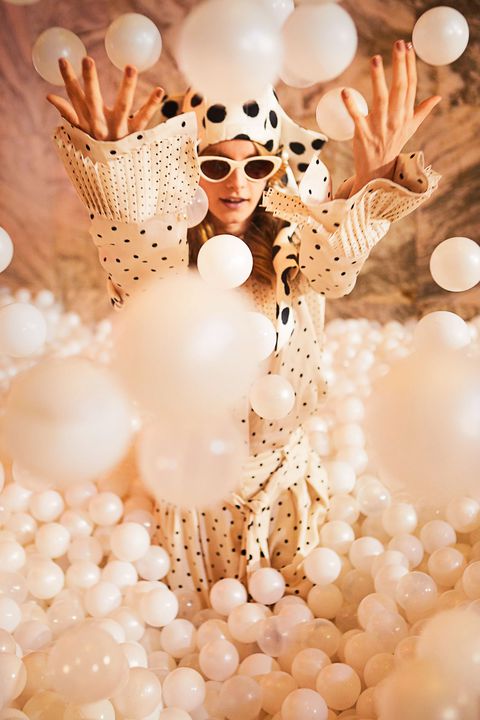
Courtesy of the designer.
Anyone who thinks the fashion industry doesn’t care about climate change would have done well to drop in at the Collina Strada show at New York Fashion Week in February. Models walked the runway wearing a collection made from 75 percent dead-stock (surplus) fabric, accompanied not by a thudding bass but by a rousing speech from the teenage environmental activist Xiuhtezcatl Martinez. The beads on the clothes came from recycled ocean plastic, a collaboration with the organization 4Ocean. For designer Hillary Taymour, the event presented an opportunity to publicly reckon with how she and her peers have fallen short when it comes to sustainability.
Fashion brands’ green initiatives can often come across as lip service: While the claim that the industry is the second-most-polluting in the world has been debunked, its toll on the environment is undeniably significant, marked by widespread chemical use and a heavy carbon footprint. Meanwhile, fast fashion encourages shoppers to refresh their closets constantly, sending clothing from sales floor to landfill with alarming speed. According to the Ellen MacArthur Foundation, 73 percent of materials used to produce clothing end up either in landfills or burned; less than 1 percent is reused.
But a growing number of designers and executives seem intent on having a serious conversation about sustainability—and, more importantly, making real moves to decrease their environmental impact. We’re not just talking about the longtime environmental champions, like Stella McCartney, a leader in the use of materials like vegetarian leather and faux fur, and Livia Firth, cofounder of the sustainability consultancy firm Eco-Age and creator of the Green Carpet Challenge. (The latter uses red-carpet moments to raise awareness of environmentally friendly fashion. What better way to get the public excited about sustainability than Gisele in a fabulous gown?) It’s now de rigueur for luxury brands to have an executive devoted to all things green. Cases in point: Marie-Claire Daveu, chief sustainability officer at Kering, and Sylvie Bénard, corporate environment director at LVMH.
There’s an entire fashion task force tackling the plastic problem. We’ve all seen the horrifying images of trash-strewn shores and realized we need to stem the tide. Burberry has set a goal of making all its plastic packaging reusable, recyclable, or compostable by 2025, and Courrèges artistic director Yolanda Zobel is phasing out vinyl from her collections for the brand, which became closely associated with the Space Age material in the 1960s. (Thinking about the future sometimes requires getting creative about honoring the past.)
Denim is one of the most problematic sectors of the fashion industry because its production pollutes and wastes water. But labels have become more conscious of the issue. Last year, G-Star Raw launched what it calls its Most Sustainable Jeans Ever; its summer 2019 collection took things one step further by using just a two-dip (rather than the usual eight-dip) dyeing process—saving 75 percent of the water normally required.
Others are focusing on maximizing what they have. Young designers such as Marine Serre and Chromat’s Becca McCharen-Tran have leaned into crafting clothing from surplus fabrics, a restriction that hasn’t limited the exuberance of their work in the least. Chopard, under the guidance of eco-minded artistic director and co-president Caroline Scheufele, has become a proponent of ethically sourced gold and has minimized its reliance on new metals by recycling as much as 70 percent of its own production waste.
Streamlining production doesn’t just happen on the factory floor. Photographer Alexi Lubomirski, best known to the world for taking Prince Harry and Meghan Markle’s official engagement and wedding pictures, strives to conduct his fashion shoots with the smallest carbon footprint possible. In April, he launched the Creatives4Change initiative, asking his colleagues to cease working with fur, feathers, and exotic skins, which the photographer already avoids in his own work. Diane von Furstenberg and power photography duo Inez van Lamsweerde and Vinoodh Matadin have already signed on.
Entrepreneur Carmen Busquets, who predicted the rise of luxury e-commerce as a founding investor of Net-a-Porter, sees sustainability as the new way forward. She has made it a point to invest in companies like Unmade, which aims to stanch mass production by enabling brands to offer custom clothing on demand, and Sana Jardin, a fragrance company with a closed-loop production system that turns its waste into products like scented candles and orange blossom water. Nadja Swarovski of crystal maker Swarovski, in addition to sitting on the company’s executive board and leading its sustainability efforts, set up the Swarovski Foundation in 2013 to support environmental organizations like the Nature Conservancy and Barefoot College.
Increasingly, it seems that there’s a cost to not establishing sustainability measures. With growing consumer attention on our environmental crisis, brands that don’t make moves to reduce their impact are inevitably going to miss out. Fashion may never be completely zero waste, but that’s no reason not to try.
This article originally appeared in the July 2019 issue of ELLE.












